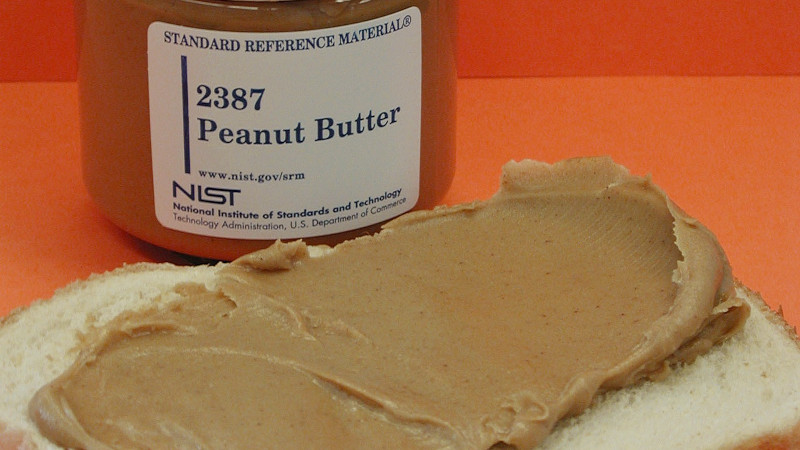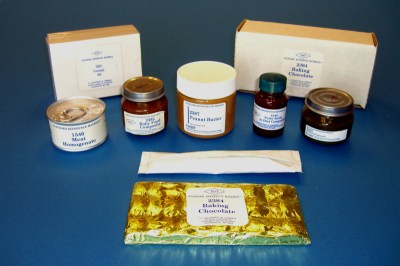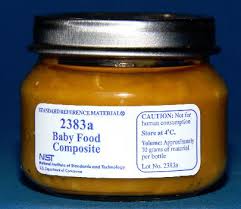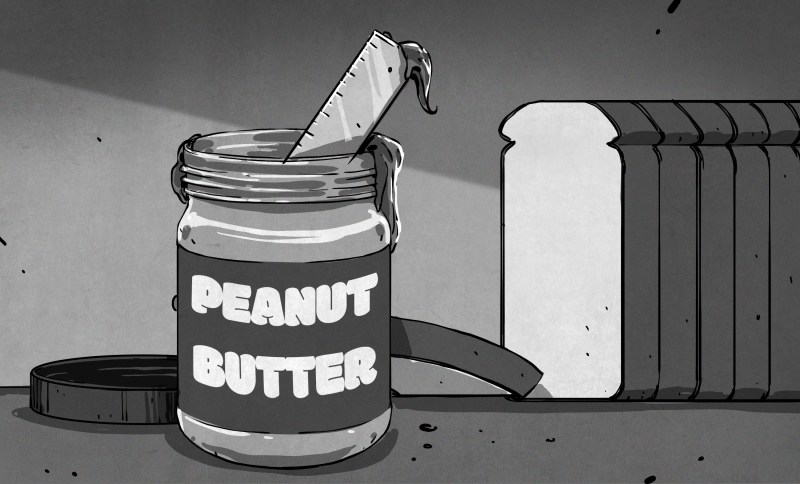The National Institute Of Standards and Technology was founded on March 3, 1901 as the National Bureau of Standards, taking on its current moniker in 1988. The organisation is charged by the government with ensuring the uniformity of weights and measures across the United States, and generally helping out industry, academia and other users wherever some kind of overarching standard is required.
One of the primary jobs of NIST is the production and sale of Standard Reference Materials, or SRMs. These cover a huge variety of applications, from steel samples to concrete and geological materials like clay. However, there are also edible SRMS, too. Yes, you can purchase yourself a jar of NIST Standard Peanut Butter, though you might find the price uncompetitive with the varieties at your local supermarket. Let’s dive into why these “standard” foods exist, and see what’s available from the shelves of our favourite national standards institute.
Know Thine Measurements

NIST produce approximately 1300 different Standard Reference Materials, with 45 of those being in the Food and Beverage category. They’re most famous for their peanut butter, which got attention online when a photo of Dr. Carolyn Burdette testing samples of the material went viral. The range of standards available is vast, though largely unpalatable, with such items as Meat Homogenate and Infant/Adult Nutritional Powder available.

It’s fun to think about a government organisation creating a “standard” peanut butter to rule them all, one neither better nor worse than one could expect a peanut butter to be. However, these standards are not intended to be a guide on how manufacturers should craft their foods. Instead, the materials are intended for use as calibration standards.
Manufacturers need to verify the nutritional content of their foods, and also need to verify that they’re safe and free of dangerous contaminants. This requires the use of a variety of complex tests. In order to verify that the results of these tests are valid, it’s necessary to have a known standard material on hand to check with. For example, if you run a test on NIST’s standard apple juice, and your measured levels for arsenic match the documented values, you can be relatively certain that when you measure your own company’s product, the numbers you get are valid.

While the NIST standards could technically be considered edible, they’re not intended to be ingested, and prices are orders of magnitude higher than what you’d pay at your local store. A 3-pack of standard peanut butter will set you back $881 before shipping, while five bars of baking chocolate will cost you the same. Suffice to say, NIST aren’t known for handing out holiday promo codes, either. If we had to cater a picnic with nothing but SRMs, we’d lean on the milk & egg powders along with flour samples to bake a nice standard loaf of bread, topped with either oyster tissue (a steal at $672 for 25 grams), bovine liver, or perhaps the slurried spinach for those wanting a vegetarian option.
Overall, these reference materials serve an important role in ensuring the quality of the foods and beverages we consume every day. Combined with the formal, bleak aesthetic of their label designs, they also make an excellent gag prop for your refrigerator, albeit at great cost. NIST’s work makes life easier for manufacturers, and helps produce better products for consumers. Thus, the enigmatic Standard Reference Materials play an highly important role in the food and beverage industry.
















How did you miss mentioning the ANSI standard pizza and the ISO cup of tea ?
Though I’m intrigued about how these are prepared now, whether they have to have someone with a pair of tweezers counting out and adding the requisite number of rodent hairs and cockroach legs permitted by law.
Wow, not only is there a standard for tea, there are three, and they are absurdly expensive.
https://www.iso.org/standard/73224.html Tea — Preparation of liquor for use in sensory tests
https://www.iso.org/standard/6493.html Tea — Sampling
BS 6008:1980, ISO 3103-1980 Method for preparation of a liquor of tea for use in sensory tests
Relevant XKCD; https://xkcd.com/927/
I have a copy of BS 6008:1980. It’s a surprisingly reasonable method. It would also be an improvement to US tea-making capacities.
Someplace in this world a factory makes this…
Re-labelling ordinary jars would be a more cost-effective joke.
I want to relabel LOTS of my foods! Someone more artistically skilled than I am, please create & post a label template.
I went digging, thinking somebody might have done it, nothing yet, but turned up these
https://www.filmsourcing.com/free-fake-brands-and-packaging-for-film-and-tv
Which will either weird ppl out if you relabel everything in your pantry with them or make them think you shop at Aldi.
Like, way years back… my friend and I relabeled a box of Little Debbie nutty bars as “Brand X” nutty bars and went out on the street to give out samples…
“Brand-X nutty bars!! They are not made by Satan!”.
I think we got like one person to try them.
This is great. It made my day.
Ideed. How does one miss that? A good starting would have been ISO 3103 (https://www.iso.org/standard/73224.html): “Tea — Preparation of liquor for use in sensory tests”. Only 58 swiss francs for a perfect cuppa :-)
One can find the older revisions floating around, click the link if you want to see it for private study, research, review, criticism or to quote from it http://www.gatsby.ucl.ac.uk/tea/tea_archive/attached_files/BS6008.pdf
But if you want to pleasure yourself to it or use it for lyrics to a theramin composition you’ll have to pay the 58 swiss francs.
Is it April Fools day early, or did I miss something?
Yes
An education, perhaps?
No, but it could be, is it? What’s happening???? https://landing.coolermaster.com/kfconsole/
It’s like someone at KFC figured, “Hmm, I know that originally we were joking about that console thing, but it’s 2020 and apparently literally anything is possible, so why not?”
Gee, I always wanted to know KFC’s opinion on sole…
Only ever use the radiological NIST standards. Not willing to find out whether or not they’re tasty.
Go ask Galen.
“A 3-pack of standard peanut butter will set you back $881 before shipping”. $900 for standard peanut butter!? Guess I’ll have to stick to substandard peanut butter, as usual. :'(
I’m sure the US Military is a major consumer.
B^)
They probably have a lengthy spec defining it, too.
Just like milspec “cocolate” [sic] covered oatmeal cookies and covered brownies.
Is that chocolate enriched in coconut?
Unlikely, the container didn’t say “need before opening.”
Kneed?
Jars of Sun Pat peanut butter used to say “Churn well before use” when I was a kid.
Of course, in this context a “substandard peanut butter” would be peanut butter of quality that could be traced back to the NIST reference and cost almost as much.
Reminds me why labs I’ve worked in and led have secondary standard programs.
This is insane. What standards are the supposed standards tested against?
Generally the standards are tested by several widely different methods, and/or with the same kind of instrument by different manufacturers. When all methods give results that are not significantly different from one another, and all determinate errors have been removed or compensated for, it’s a good indication that the concentration of those particular components is accurate.
Without such standards, a manufacturer could with impunity adulterate apple juice with sugar water, or add cheap ground sunflower seeds to peanut butter.
It’s been a long time since I’ve seen the data sheet that comes with a standard material, but I think it includes a description of methods/techniques to use for best results.
no, these standards do not prevent adding sweetened water to apple juice or sunflower seeds to peanut butter. Those are prevented by food labelling laws.
These standard foods – as the article says – are used to calibrate test equipment.
Standard peanut butter with only peanuts from Trader Joe’s has a much better price whether it is creamy or
or with more nut pieces(legumes). The adulterated products with added sugar and salt are there as well.
As for cheaper sunflower seeds, they are quite delicious in chocolate covered form as sunflower seed butter.
Fun facts, there’s also a NIST standard cigarette.
… and three standards related to cigarettes in total.
I suspect the cost breakdown goes something like:
-$10-20 for some carefully prepared peanut butter
-$860 for a detailed chemical analysis of the peanut butter to prove it’s in spec.
My job involves gettting water samples and a general metals suite analysis usually runs about $500 per sample, so $880 for three samples sounds like a bargain!
Tom Scott has a video on this, not sure if Hack A Day like him or not https://www.youtube.com/watch?v=jvJzi0BXcGI
Tom Scott is awesome. Short content packed full of fascinating information and presented very well.
What would be really useful is if they could produce a standardised tragic event, which we could use to calibrate news agencies when they report on it.
Are you volunteering to be the cause or the tragedy?
Or maybe the subject?
I propose standardization of any J.D. or M.D. related process. Someone said “I second that.” All in favor, say “I”
“If we had to cater a picnic with nothing but SRMs, we’d lean on the milk & egg powders along with flour samples to bake a nice standard loaf of bread”
You’d be making cake.
Bread is flour, water, salt and yeast.
Although I am reading In defense of Food by Michael Pollan at the moment and learned that US supermarket bread may have 50+ ingredients.
And you don’t even need the salt in that list.
You could make bread without salt, but it tastes like nothing. Besides that the salt helps the dough rise, helps form a crispy crust and traps water, which help keep the bread longer.
As a part time Locksmith I learned there’s a NIST standard for master keying. As a full time Engineer I uses NIST standards all the time.
I recall when I last left off in pharma… USP/NF pharmacopeial forum was reviewing cannabis. Looks like NIST got on the bandwagon to an extent.
https://www.nist.gov/news-events/news/2020/07/nist-help-labs-achieve-accurate-thc-cbd-measurements
NIST is awesome to work with. USP/NF is a little more concerning since reminds me of the J.D. and M.D. industry. The good thing is at least companies are dedicated to Lean Six Sigma initiatives and was awesome to led that on. https://www.usp.org/dietary-supplements-herbal-medicines/cannabis
Scarier when not, especially reading into not much relating to cGNP’s compared to cGMP’s. Looks like those haven’t advanced. Bio-equivalent testing for bio-pharmaceuticals was another yikes concern a decade ago or so.
Whilst we are talking about NIST, it might be relevant to mention that they developed a CNC controller (and a standard G-code to go with it) called EMC, the Enhanced Machine Controller. This was later put in the public domain and became LinuxCNC.
https://web.archive.org/web/20101020051846/http://www.isd.mel.nist.gov/projects/_emc/
I may or may not send this to a customer asking if we use a NIST standard to calibrate our (semiconductor) tools…
:)
Do you use peanut butter in semiconductor production? :-)